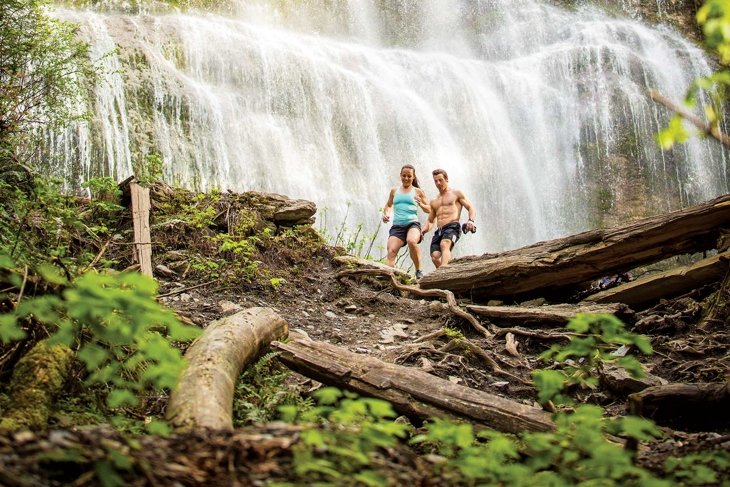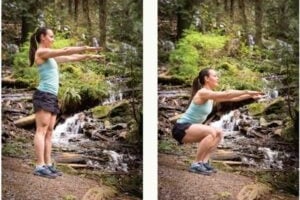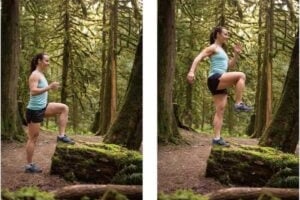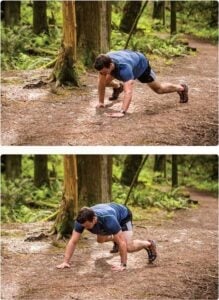
Learn about the many benefits associated with outdoor activity and try our warm-up exercises—all guaranteed to have a positive impact on your overall well-being. They’ll leave you feeling more alive!
Now that summer is here, there’s no better way to improve your fitness than to exercise in the great outdoors. Whether you’re trail running, hiking, kayaking, or mountain biking, just getting outside and interacting with nature will leave you feeling refreshed, re-energized, and focused.
Nature nurtures us
Connecting with nature is paramount to our overall health and well-being. In fact, based on recent studies that show we possess an inherent attraction toward nature, city planners are now putting more emphasis on creating functional green spaces.
Researchers hypothesize that, because our hunter-gatherer ancestors existed for thousands of years in outdoor environments, we present-day humans share an innate affiliation with nature.
The problem is that we now spend less time outdoors interacting with the natural world even though our brains are hardwired for it. Outdoor workouts allow us to reconnect with nature while providing numerous benefits.
Benefits of outdoor exercise
Stress reduction and improved mindset
Green exercise refers to physical activity that takes place outdoors in natural environments. Studies have shown that it contributes to decreased tension, confusion, and anger. Even looking at green space can decrease the stress-related hormones cortisol and adrenalin.
Exposure to natural sunlight combined with physical activity is thought to increase serotonin levels in our bodies, which can improve feelings of well-being and happiness. Serotonin is a mood-enhancing chemical, and a deficiency has been linked to depression, anxiety, fatigue, and impaired cognitive function.
As our world becomes busier, we typically experience more stress and have less time available for physical activity. In 2013, Canadians aged 15 and older described most of their days as being “extremely stressful.” Dedicating time each week to exercising outdoors will alleviate stress on busy days and actually improve mental well-being and self-esteem, and may even help fight depression.
English scientists reported that just five minutes of green exercise resulted in improvements in self-esteem and mood.
Richard Louv, author of Last Child in the Woods (Algonquin Books, 2008), coined the term “nature-deficit disorder.” He believes human beings spend less time in nature, which contributes to increased behavioural problems, especially among children.
In fact, Statistics Canada has shown that activity levels among children have steadily declined in recent years. Outdoor physical activity may help to correct these issues and dissolve unwanted stress.
Improved mental focus and commitment to exercise
The environment constantly changes when we exercise outdoors; weather, temperature, and terrain are all factors out of our control. Our minds require a great deal of mental focus to adjust to these subtle changes. As a result, we receive a temporary break from daily stressors, which can improve our ability to focus on day-to-day tasks.
Studies reveal that those who incorporate outdoor exercise into their fitness regimen have better adherence to their exercise programs. The sights, sounds, and varying terrain associated with outdoor training cannot be replicated in a gym.
Natural landscapes simply provide us with more interesting things to view. The visual distraction decreases our rate of perceived exertion allowing us to train harder and for longer periods of time. Completing a long and challenging hike, trail run, or bike ride has an addictive quality that leaves us craving more!
Better recovery from structured training
Structured physical activity in the gym is important and has a positive impact on our daily performance. Those who exercise regularly in a gym know the importance of setting goals and adhering to a strict workout regimen.
Spending too much time indoors (even exercising) can become tiring. Outdoor workouts and activities are a great supplement and do not need to be strenuous. Low intensity exercises such as walking can be a powerful tool for recovery from intense, structured gym workouts. They increase blood flow to trained muscles and help deliver oxygen and nutrients.
If you are growing bored with your exercise routine, try incorporating one or two days of outdoor exercise and give yourself the freedom to engage in more varied, exciting movements out in nature. Exposure to fresh air and sunlight will leave you feeling refreshed.
Boosted levels of vitamin D
For most of us, the majority of our time is spent indoors. Combined with the fact that Canada is situated so far north, this means our sun exposure is limited during certain times of the year. Outdoor training in the summer months will help ensure we are receiving adequate levels of “the sunshine vitamin.”
When exposed to UVB rays from the sun, our bodies naturally convert cholesterol in our skin to vitamin D3. Health Canada suggests the recommended dietary allowance per day for adults is 600 IU. Deficiency of vitamin D has been linked to increased risk of a host of chronic diseases, such as osteoporosis, heart disease, and some cancers.
In the summer months, our skin only requires a few minutes of daily sun exposure in order to maintain adequate levels. There are many factors that influence the exact exposure needed, such as ethnicity, amount of skin exposed, age, and the UV index.
Incorporates different muscle groups
Outdoor sports and activity utilize different muscle groups than structured indoor workouts. For example, trail running and hiking are more difficult than exercising on a treadmill. The uneven terrain requires more lateral movements and the activation of stabilizer muscles throughout our ankles, knees, and core.
Mountain biking requires far more balance and coordination than a stationary or recumbent bike. Additional upper-body strength is also required for control and quick movements.
Adds some fun and variation
Outdoor training and indoor exercise are both important to overall health and wellness. The key is to find a balance between the two and maximize the benefits that both have to offer. After all, there is no better feeling than seeing the positive impact indoor training has on your ability to perform your favourite outdoor activity.
Take advantage of the nice weather and challenge yourself with a new activity. Perhaps it will be a new trail run or mountain bike route, or maybe you’ll attempt paddleboarding for the first time. Either way, partaking in a new activity is both exciting and rewarding.
Warm up for outdoor activities
A warm-up is a great way to prepare your body for activity. It consists of a series of movements designed to loosen tight muscles, increase blood flow, and activate your nervous system. Here are five exercises to get you ready for your favourite activity. Complete two rounds and 15 to 20 repetitions of each exercise.
Take a nature break
On your lunch break, go for a short walk in nature to feel rejuvenated and more focused for the remainder of your day.
Before you head outside
Protect yourself from the sun
Although some sun is good for you, too much can be dangerous. Cover up exposed skin or wear sunscreen with a minimum SPF of 30.
Keep hydrated
Muscles that are hydrated function better, so make sure to drink water before, during, and after exercise. If you are exercising hard in hot weather for longer than one hour, you should consume a sports beverage that contains carbohydrates and electrolytes.
Avoid extreme temperatures
On hot days, exercise in the morning or in the evening when the temperatures are lower. This will help prevent heat-related illnesses such as heat exhaustion and heat stroke.
Body Weight Squat

- Stand tall, and extend your arms straight out in front of you with your palms down and feet flat on the ground.
- Engage your core, bend your knees, and drive your hips back, making sure to keep your back straight.
- Keep your shins vertical and imagine yourself sitting into a chair.
- Return to the starting position and squeeze your butt as you extend through the movement.
Mountain Climber

- Get into a push-up position with your feet together and legs straight.
- Squeeze your butt and engage your core to neutralize your hips.
- Drive your knees toward your chest in a controlled motion one at a time.
Step-Up with Knee Raise

- Begin by placing your left foot on top of a bench. Extend through the hip and knee of your front leg and stand up on the bench.
- Squeeze your butt to engage your glutes.
- Raise your right knee to 90 degrees.
- Lower your right leg back to the ground and repeat this movement on the same side.
Bear Crawl

- Start off on all fours with your back flat and parallel with the ground, core engaged, and hands under your shoulders.
- Crawl forward, leading with your left arm and right leg simultaneously.
- Repeat with the opposite sides as you move forward.
Forward Leg Swing

- Supporting yourself on an object, keep your posture tall and core engaged.
- Lightly start to swing your left leg and gradually increase your range of motion.
- Relax your hip joint as much as possible.
- Repeat on the right side.
















